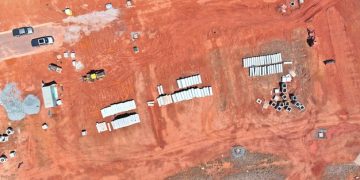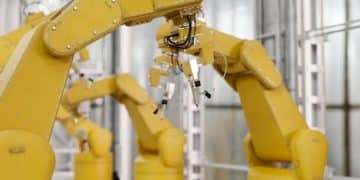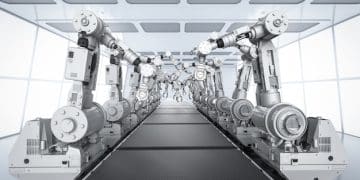The Latest Drone Technology Advancements Impacting US Industries
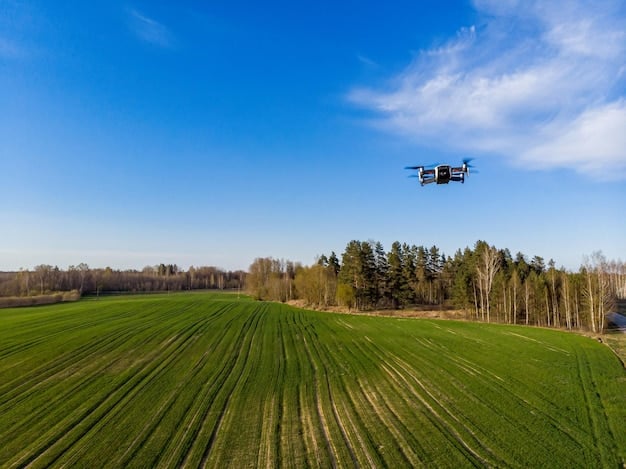
The Latest Advancements in Drone Technology and Their Impact on US Industries include enhanced automation, improved battery life, advanced sensor technology, and sophisticated data analytics, revolutionizing sectors such as agriculture, delivery services, construction, and public safety in the United States.
The Latest Advancements in Drone Technology and Their Impact on US Industries are transforming how businesses operate across the United States. From precision agriculture to rapid delivery services, drones are becoming indispensable tools. This article explores these innovations and their profound effects on various sectors.
The Evolution of Drone Technology
Drone technology has evolved rapidly over the past decade, transforming from simple remote-controlled aircraft to sophisticated tools with a wide array of applications. These advancements have significantly impacted various sectors in the United States, driving efficiency and innovation.
Early Stages of Drone Development
Initially, drones were primarily used for military applications, providing surveillance and reconnaissance capabilities. However, as technology advanced and costs decreased, drones began to find their way into civilian sectors.
Key Technological Milestones
- Improved Battery Life: Modern drones can now fly for extended periods, enhancing their utility in various applications.
- Advanced Sensors: High-resolution cameras, thermal sensors, and LiDAR technology enable drones to capture detailed data.
- Enhanced Automation: GPS and AI-driven automation allow drones to perform tasks with minimal human intervention.
These technological milestones have paved the way for drones to become essential tools in industries across the US, ranging from agriculture to construction. Their ability to collect and analyze data efficiently has revolutionized many traditional practices.
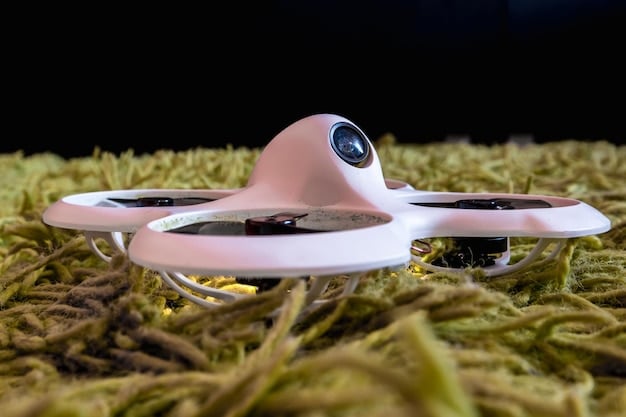
The integration of these technologies has not only improved the operational capabilities of drones but has also spurred innovation in data processing and analytics, leading to more informed decision-making in various industries. As drone technology continues to advance, its impact on the US economy is expected to grow even further.
Drones in Agriculture: Precision Farming
Drones are revolutionizing agriculture through precision farming techniques, enabling farmers to optimize their operations and increase yields. By providing detailed insights into crop health and field conditions, drones are helping to improve efficiency and reduce waste.
Crop Monitoring and Analysis
Drones equipped with multispectral cameras can assess crop health by analyzing different wavelengths of light. This data helps farmers identify areas of stress or disease early on.
Optimized Irrigation and Fertilization
Using drone-collected data, farmers can optimize irrigation and fertilization strategies, ensuring that resources are applied where they are needed most. This targeted approach minimizes waste and maximizes crop yields.
- Reduced Resource Consumption: Precision farming reduces water and fertilizer usage, leading to cost savings and environmental benefits.
- Improved Crop Yields: Early detection of issues allows for timely intervention, preventing significant losses.
- Data-Driven Decision Making: Farmers can make informed decisions based on accurate and comprehensive data.
The adoption of drones in agriculture is transforming traditional farming practices, making them more efficient and sustainable. As drone technology continues to improve, its role in precision farming will become even more critical.
The integration of drones into agriculture is not just a technological advancement but a fundamental shift in how farming is approached. By providing real-time data and actionable insights, drones are empowering farmers to make smarter decisions and achieve better results. This ultimately leads to more sustainable and profitable agricultural operations.
Drones in Delivery Services: Transforming Logistics
Drones are transforming the logistics and delivery services industry by offering faster, more efficient, and cost-effective solutions. From delivering packages in urban areas to transporting medical supplies in remote locations, drones are reshaping how goods are moved.
Last-Mile Delivery Solutions
Drones are particularly well-suited for last-mile delivery, the final leg of the supply chain that is often the most expensive and time-consuming. They can navigate congested urban areas and bypass traffic, delivering packages directly to customers’ doorsteps.
Medical Supply Transportation
In remote or hard-to-reach areas, drones can transport essential medical supplies, such as vaccines and medications, more quickly and reliably than traditional methods. This can be life-saving in emergency situations.
- Faster Delivery Times: Drones can significantly reduce delivery times, especially in urban areas.
- Reduced Costs: Drone delivery can be more cost-effective than traditional methods, particularly for small packages.
- Increased Accessibility: Drones can reach remote areas that are difficult to access by traditional means.
The use of drones in delivery services is poised to revolutionize the logistics industry, offering numerous benefits to businesses and consumers alike. As regulations evolve and technology improves, drone delivery will become increasingly widespread.
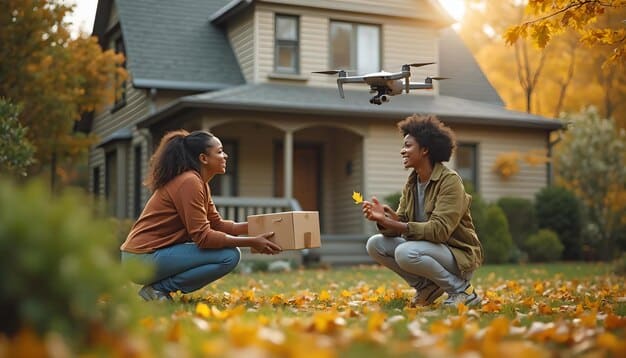
Drone delivery is not just about speed and convenience; it’s also about creating more resilient and efficient supply chains. By reducing reliance on traditional transportation methods, drones can help businesses adapt to changing market conditions and meet the evolving needs of customers. This adaptability is crucial in today’s fast-paced and unpredictable business environment.
Drones in Construction: Monitoring and Inspection
Drones are becoming essential tools in the construction industry, providing valuable insights for monitoring project progress, conducting inspections, and ensuring safety. Their ability to capture high-resolution images and videos from above offers a unique perspective that can improve efficiency and reduce risks.
Site Monitoring and Progress Tracking
Drones can regularly survey construction sites, capturing images and videos that are used to track progress and identify potential issues. This data can be compared to project plans to ensure that work is on schedule.
Infrastructure Inspection
Drones are used to inspect bridges, buildings, and other infrastructure, identifying damage or deterioration that may not be visible from the ground. This allows for timely repairs and prevents costly failures.
- Improved Safety: Drones can inspect dangerous areas without putting workers at risk.
- Increased Efficiency: Site monitoring and inspections can be completed more quickly and efficiently.
- Better Data Quality: High-resolution images and videos provide detailed information for analysis.
The use of drones in construction is transforming how projects are planned, managed, and executed. By providing real-time data and actionable insights, drones are helping to improve efficiency, reduce costs, and ensure safety on construction sites.
The construction industry is constantly seeking ways to improve efficiency and safety, and drones provide a powerful tool for achieving these goals. By integrating drone technology into their operations, construction companies can gain a competitive edge and deliver projects more effectively. This innovation is driving significant improvements across the industry.
Drones in Public Safety: Search and Rescue
Drones are playing an increasingly important role in public safety, particularly in search and rescue operations. Their ability to quickly cover large areas and provide real-time video feeds makes them invaluable tools for first responders.
Search and Rescue Missions
Drones equipped with thermal cameras can locate missing persons, even in low-light or challenging terrain. They can also be used to assess the extent of damage after natural disasters.
Law Enforcement Applications
Law enforcement agencies use drones for surveillance, crime scene investigation, and traffic monitoring. This helps to improve public safety and reduce response times.
- Faster Response Times: Drones can quickly reach remote or difficult-to-access areas.
- Enhanced Situational Awareness: Real-time video feeds provide valuable information to first responders.
- Reduced Risk to Personnel: Drones can perform dangerous tasks, minimizing the risk to human operators.
The integration of drones into public safety operations is enhancing the capabilities of first responders, allowing them to save lives and protect communities more effectively. As technology improves, the role of drones in public safety will continue to expand.
The use of drones in public safety is not just a technological advancement; it’s a humanitarian effort. By providing quick and efficient support in critical situations, drones are making a real difference in the lives of people and communities. This dedication to public service is at the heart of the drone technology’s impact on society.
Challenges and Future Trends in Drone Technology
While drone technology offers numerous benefits, there are also challenges that need to be addressed to realize its full potential. These include regulatory issues, privacy concerns, and technological limitations. Overcoming these challenges will pave the way for future advancements and broader adoption of drones.
Regulatory Frameworks
Governments are working to develop comprehensive regulatory frameworks for drone operations, addressing issues such as airspace management, licensing, and safety standards. These regulations will help to ensure the safe and responsible use of drones.
Privacy Concerns
The use of drones raises privacy concerns, particularly regarding surveillance and data collection. Measures need to be taken to protect individuals’ privacy rights while still allowing for the beneficial use of drone technology.
- AI-Powered Drones: Artificial intelligence is enhancing drone capabilities, enabling autonomous flight and advanced data analysis.
- Improved Battery Technology: Ongoing research is focused on developing longer-lasting batteries for drones.
- Expanded Applications: Drones are being used in new and innovative ways, from environmental monitoring to infrastructure maintenance.
The future of drone technology is promising, with ongoing research and development focused on addressing challenges and expanding its capabilities. As regulations evolve and technology improves, drones will play an even greater role in various sectors.
The continuous innovation in drone technology is not just about creating more advanced machines; it’s about finding solutions to pressing global challenges. By pushing the boundaries of what’s possible, researchers and engineers are paving the way for drones to contribute to a more sustainable, efficient, and safe future. This forward-looking perspective is essential for realizing the full potential of drone technology.
| Key Point | Brief Description |
|---|---|
| 🌱 Precision Farming | Drones monitor crops, optimizing irrigation and fertilization. |
| 📦 Delivery Services | Drones offer faster and more efficient last-mile delivery. |
| 🏗️ Construction Monitoring | Drones track site progress and conduct infrastructure inspections. |
| 🚨 Public Safety | Drones aid in search and rescue and law enforcement operations. |
Frequently Asked Questions
▼
Drones in agriculture monitor crop health, optimize irrigation, and provide data-driven insights for better resource management and higher yields.
▼
For delivery services, drones provide faster last-mile delivery, reduce costs, and increase accessibility to remote areas, enhancing overall efficiency.
▼
Drones monitor construction sites by tracking progress, conducting inspections, and providing high-resolution images for better project management and safety.
▼
Drones assist in public safety by aiding in search and rescue missions, providing real-time surveillance, and improving law enforcement’s response times.
▼
Key challenges in drone technology adoption include regulatory frameworks, privacy concerns, and technological limitations that need to be addressed for broader use.
Conclusion
The Latest Advancements in Drone Technology and Their Impact on US Industries are undeniable, with applications ranging from agriculture to public safety. As technology evolves and regulations adapt, drones will continue to revolutionize various sectors, driving efficiency, innovation, and growth across the United States.
